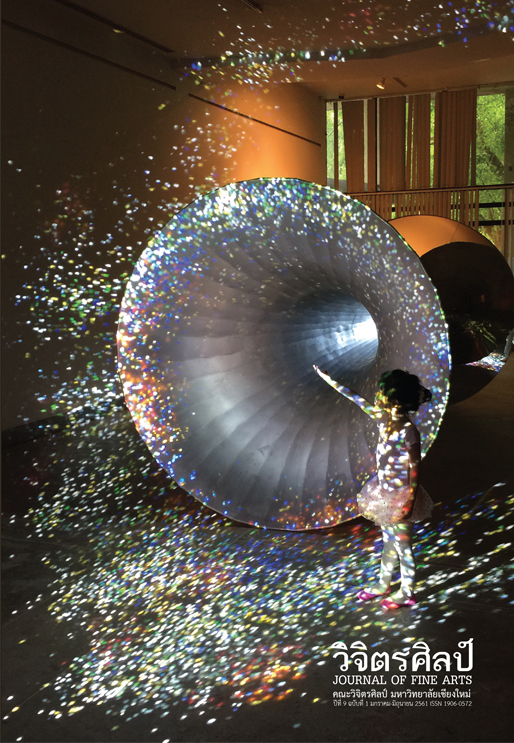สร้างสรรค์มาจากเหมืองฝายล้านนา
Main Article Content
Abstract
From this study on Lanna wisdom of irrigation ditches and weirs in Mae Sa River Basin, Mae Raem Sub-district, Mae Rim District, Chiang Mai Province, it is discovered that ancient weirs that the locals have used for agricultural purposes since the past have been changed in term of the mode of utilization from agricultural purposes to the production of pipe water. Since the need for water increases every year, the abandonment of weirs and water sources in communities causes the problems related to water conflicts. In drought seasons, the amount of water does not meet the need for water for agricultural works and consumption. On the contrary, during a rainy season, wild water floods over agricultural fields, and households, and natural tourist attractions such as Mae Sa waterfall have to be temporarily closed. In this study and research project, the weir-related wisdoms are applied to the arrangement of activities to encourage members of related communities to treasure water sources of communities through the activities of forestation (to grow trees in deforested areas), and to build small weirs in branch streams that run to the main river. Small weirs in the unmanaged regions of a mountain help retain water during a dry season and slowdown water flow when there is a heavy rain. The power of youths and other people will be important forces that urge communities to be aware of the solutions to water crises and to have common awareness in the weir-based traditions that will be factors that make people rehabilitate water sources again through the rites of worship to the water spirits and to bless water.
From the study on weir and ditch systems and the arrangement of activities with the communities, the attained bodies of knowledge are implemented to the creation of art works in the ‘Ditches and Weirs, Flow of Wisdoms between Human Beings and Mother Nature’ Project that uses the systems of water retention, circulation and flow from wisdoms of weirs. The used materials are bamboo sticks, cement, soil, rock and sand that are aligned with natural environs. It is apparent that when the light has a contact with the surface of water that is running to the direction of the flows from upper levels to lower ones, there is glittering light reflected on the walls and natural environs around the works. The reflections of light move into the same directions sometimes and different directions sometimes, the end fades away over time. People acknowledge that they cannot take control the natural.
Article Details
References
ฟื้นฟูปฐพีไทยเขตพัฒนาที่ดินลุ่มน้ำแม่สา ตำบลโป่งแยง อำเภอแม่ริม
จังหวัดเชียงใหม่. กรุงเทพฯ: กรมพัฒนาที่ดิน กระทรวงเกษตรและ
สหกรณ์, 2546.
2. กรมศิลปากร. ประชุมพงศาวดาร ภาคที่ 61. กรุงเทพฯ: ชวนการพิมพ์, 2516.
3. กุลพล อมตอาชาชัย. ประสิทธิผลของการแปลงสินทรัพย์เป็นทุนในอุทยาน
แห่งชาติดอย สุเทพ-ปุย: กรณีศึกษาบริเวณผาดำและน้ำตกแม่สา.
เชียงใหม่: บัณฑิตวิทยาลัย มหาวิทยาลัยเชียงใหม่, 2549.
4. จุฬาลงกรณ์มหาวิทยาลัย. เจ้าดารารัศมี. กรุงเทพฯ: จุฬาลงกรณ์มหาวิทยาลัย,
2557.
5. ดวงแก้ว สนินัด. ประวัติขุนหลวงพะลังคะ กับพระนางเจ้าจามเทวี ตำรายา
สมุนไพรพื้นบ้าน รวมพิธีแผนโบราณ. เชียงใหม่: ม.ป.พ, 2548.
6. บุญคิด วัชรศาสตร์. พระธรรมเทศนาพื้นเมืองเหนือเรื่อง มัจฉาพระยาปลา
ช่อน. เชียงใหม่: ธาราทองการพิมพ์, ม.ป.ป.
7. ปรีชา เถาทอง. แนวความคิดสร้างสรรค์งานจิตรกรรมของ ปรีชา เถาทอง.
กรุงเทพฯ: โรงพิมพ์พิฆเณศ, 2522.
8. พรทิพย์ เธียรธีรวิทย์. ชลประทานราษฎร์: การจัดการน้ำโดยชุมชน. เชียงใหม่:
คณะเศรษฐศาสตร์ มหาวิทยาลัยเชียงใหม่, 2543.
9. พรพิไล เลิศวิชา และอรุณรัตน์ วิเชียรเขียว. ชุมชนหมู่บ้านลุ่มน้ำขาน.
กรุงเทพฯ: สำนักงานกองทุนสนับสนุนการวิจัย, 2546.
10. พรพิไล เลิศวิชา และคณะ. เหมืองฝาย: จัดการน้ำ จัดการคน บนพื้นฐาน
ภูมิศาสตร์และวัฒนธรรม. เชียงใหม่: ธารปัญญา, 2552
11. คณะวิศวกรรมศาสตร์, มหาวิทยาลัยเชียงใหม่. โครงการบริหารจัดการ
ทรัพยากรน้ำจังหวัดเชียงใหม่: แผนพัฒนาและจัดการทรัพยากรน้ำ
ระดับอำเภอ. เชียงใหม่: คณะวิศวกรรมศาสตร์มหาวิทยาลัยเชียงใหม่,
2553.
12. ยศ สันตสมบัติ. ความหลากหลายทางชีวภาพและภูมิปัญญาท้องถิ่นเพื่อการ
พัฒนาอย่างยั่งยืน. เชียงใหม่: ภาควิชาสังคมวิทยาและมานุษยวิทยา
คณะสังคมศาสตร์ มหาวิทยาลัยเชียงใหม่, 2542.
13. ศรีเลา เกษพรหม. ลัวะเยียะไร่ ไทใส่นา. เชียงใหม่: มิ่งเมือง, 2541.
14. อรุณรัตน์ วิเชียรเขียว และเดวิด เค. วัยอาจ. ตำนานพื้นเมืองเชียงใหม่.
กรุงเทพฯ: ตรัสวิน, 2543.
15. อุดม รุ่งเรืองศรี. สารานุกรมวัฒนธรรมไทย ภาคเหนือ เล่มที่ 15. กรุงเทพฯ:
มูลนิธิสารานุกรมวัฒนธรรมไทย ธนาคารไทยพาณิชย์, 2542.
16. Ogilvie, E. Bodies of water. Nethergate: Dundee Contemporary
Arts, 2005.
17. Wittenborn, R & Biegert, C. A River drowned by water: the James
Bay project. Bangkok: Goethe-Institute, 1991.


